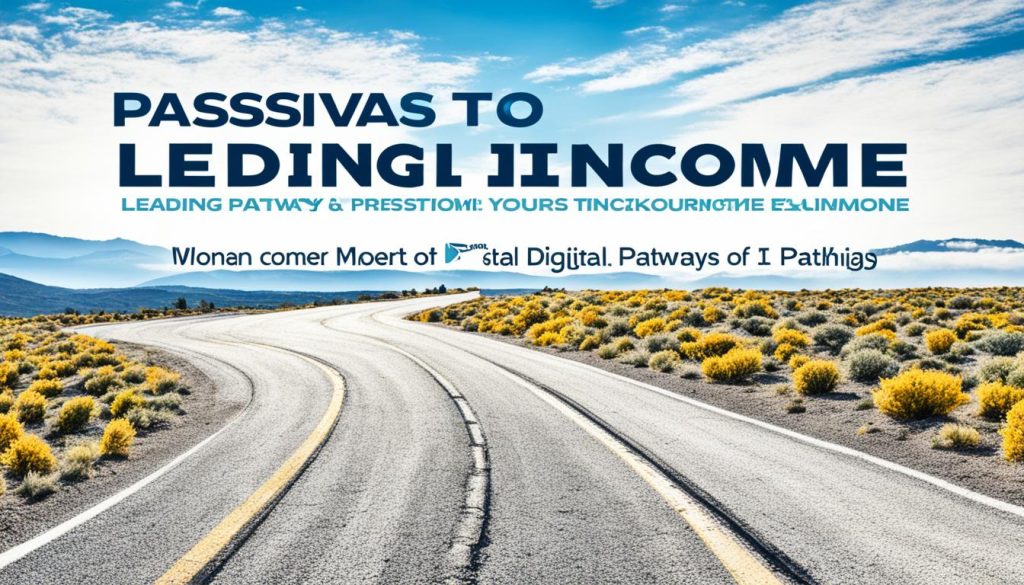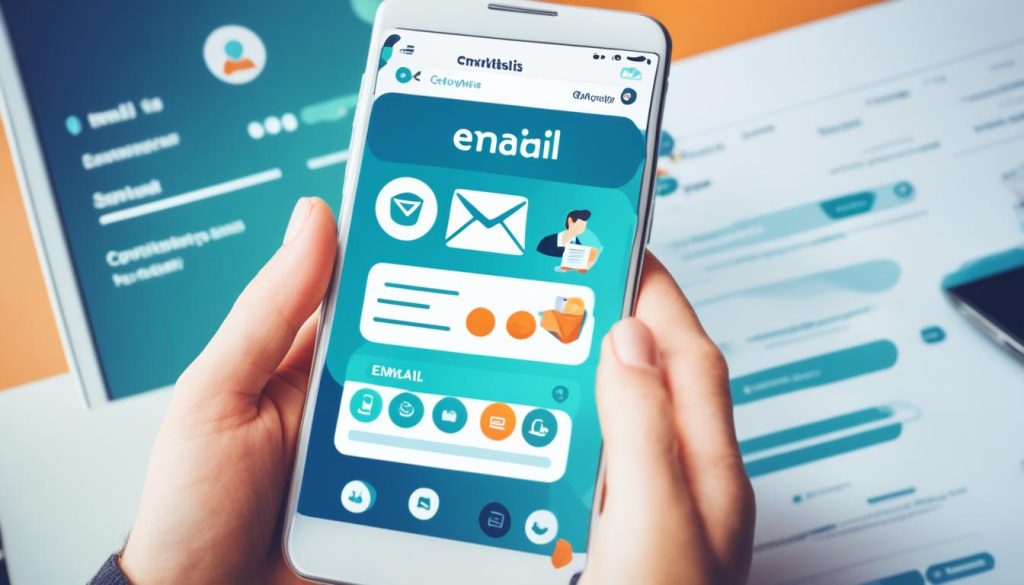Did you know blogging can make money while you sleep? It’s true! With today’s uncertain job trends, generating extra cash through blogging is smart. It’s a great way to earn on the side without a lot of work.
Sure, blogging is often seen as a fun hobby. But it’s also a way to make real money. You don’t need a lot to start, and the earning potential is huge. You can write about what you love or know well and start earning. Blogging could become your main source of income too, if you’re really into it.
Is it Possible to Earn Passive Income from Blogging?
Yes, you can earn passive income with a blog. By using the right methods, your blog can generate a full-time income without constant effort. There are three main methods: ads, affiliate links, and selling digital items. Other ways like sponsored posts and services can also make money, but they need more of your time.
Earning Passive Income through Ads
Ads are a key way to earn passive money with your blog. By working with companies like Mediavine or Ezoic, you can earn from display ads. The more people visit your site, the more you can make from these ads.
Earning Passive Income through Affiliate Links
Affiliate marketing is a great method for passive income. By promoting products or services related to your blog, you earn money when people buy through your link. It’s important to choose products your audience will appreciate.
Earning Passive Income through Digital Products
Selling digital items like ebooks is another good method. Once you make the product, you can sell it many times without much more work. It’s essential to have an email list for selling digital products. This helps you connect with potential buyers.
Using these methods, you can make your blog a source of passive income. But, remember that a lot of work upfront is needed. You have to build your blog, create great content, and connect with advertisers. Even though blogging requires some effort, it can provide a good income stream with less active work.
Interested in more ways to earn money from your blog? Check out this Forbes article.
Earning Passive Income through Ads
Blogging can help you earn money passively. Ads are a major source of this income. Companies like Mediavine, Ezoic, and AdThrive help bloggers by managing ads on their sites.
These ad companies connect bloggers with advertisers. They also handle placing and optimizing ads. This service makes your job easier, allowing you to focus on your blog’s content instead of ad management.
By working with them, your blog gets ads. And the more people visit your blog, the more money you can make from these ads. It’s that simple.
Advertisements come in different types and designs, such as banners and native ads. It’s important to place them strategically. You want them to be noticed without ruining your readers’ experience.
Your ad revenue depends on many things, like your blog’s topic and how many people visit. But with the right ad partner and enough blog visitors, you can make a good income. This passive income can make a big difference in your finances.
However, you must be careful with ads. Too many or poorly placed ads can harm your blog’s credibility. Finding the right number and better placement is important. It keeps your blog profits up and your readers happy.
Interested in learning more about making money with your blog? Visit this Forbes article for tips and tricks.
Comparison of Ad Management Companies
| Ad Management Company | Earnings Potential | Minimum Traffic Requirement | Application Process |
|---|---|---|---|
| Mediavine | High | 25,000 monthly sessions | Online application and review |
| Ezoic | Medium to High | 10,000 monthly sessions | Online application and website integration |
| AdThrive | High | 100,000 monthly pageviews | Application, review, and onboarding process |
Choosing the right ad management company can be crucial. Comparing them is a smart way to find what suits your blog best. Look at things like earnings, traffic requirements, and how to apply.
Earning Passive Income through Affiliate Links
A great way to earn money from your blog passively is through affiliate marketing. It means I work with companies to sell their stuff to my readers. If someone buys something using my link, I earn a bonus. So, I help companies find new customers, and I make money without working more.
Choosing the right things to promote is key. I pick items that fit my blog’s theme and appeal to my readers. By doing this, I earn my followers’ trust and they are more likely to buy what I recommend.
Affiliate marketing feels natural to me. I share my honest opinions about what I’m selling, making it easier for readers to decide. They get honest advice, and I get a cut of the sales. It’s a great way for me to earn without being salesy.
To make the most of affiliate marketing, I constantly look for new programs and update my content. By watching what works and what doesn’t, I can keep increasing my earnings over time.
Benefits of Affiliate Marketing for Bloggers:
- Earning passive income: I make money in my sleep with affiliate marketing. After putting the links in my blog, the cash keeps coming as long as people keep reading.
- Diversifying income streams: I don’t rely on just one paycheck. By adding affiliate work, my blog gets more stable financially.
- Flexibility and scalability: I choose what to sell, which is great for my blog and my readers. And, the more my blog grows, the more money I can make.
Affiliate marketing is awesome for making extra money from your blog while helping your readers too. By working with trusted companies and giving honest reviews, I turn my blog into a money-making machine. It’s a dream come true for many bloggers.
| Affiliate Marketing Tips for Bloggers | Benefits |
|---|---|
| Choose affiliate programs that align with your blog’s niche | Increase the likelihood of generating sales and earning commissions |
| Create thorough and informative product reviews | Establish authority and trust with your audience |
| Focus on promoting products or services you genuinely believe in | Build authenticity and strengthen your relationship with your audience |
| Track and analyze your affiliate marketing performance | Identify successful strategies and optimize your approach |
Earning Passive Income through Digital Products
Creating and selling digital products can help you make money without daily work. You initially create these items like ebooks, online courses, or digital art. After that, you can sell them over and over, boosting your income.
To sell well, you need an email list. This list helps you reach out to interested people directly. You can share special offers and keep them interested in what you offer through emails.
Focus on what your audience wants when making digital items. Think about what problems they have. Then, find ways to solve these issues through your products. This can make customers want to buy more from you.
It’s also smart to mix products together or offer advanced versions. This way, your customers get more value. And you can make more money this way, too.
Think hard, research well, and craft with care when making digital products. Your content should offer real value. This way, your customers feel happy with their purchase. They should learn something useful from what you’re selling.
Examples of Profitable Digital Products:
| Product | Benefits |
|---|---|
| Ebooks | Portability, affordability, and in-depth knowledge |
| Online Courses | Structured learning, expert guidance, and interactive elements |
| Templates | Time-saving, customizable, and professional designs |
| Digital Artwork | Visual appeal, decorative purposes, and personalization |
Market your digital products well. Use your blog, social media, and ads to reach people. Brag about what’s good about your products. Show off happy customer stories. With the right moves, your digital items can make good money for you.

If you want more tips on making and selling digital products, check out this article on Business Insider: How to Make Money Online: Passive Income Digital Product Ideas.
The Reality of Passive Income from Blogging
Passive income from blogging isn’t quick cash. You need to put in work upfront. This means making valuable content, improving it for search engines, and connecting with advertisers and affiliates. Yet, when your blog makes money, you gain more freedom to work when and how you want.
It’s true that blogging isn’t totally hands-off. But, it can bring in a good income stream with little day-to-day effort. To turn your blog into a source of passive income, use ads, affiliate links, and digital product sales. These can keep money coming in while you’re not working.
Adding ads to your blog can be a great start for passive income. By working with ad management companies like Mediavine or Ezoic, you can put ads on your site. You’ll earn more as your blog gets more visitors.
Working as an affiliate marketer is also effective for passive income. You earn a cut each time someone buys through your referral link. Make your blog posts helpful and tie in the affiliate links naturally. This can increase your chances of making money this way.
Owning Your Products
Selling your digital products, like ebooks or courses, is a powerful way to make money. Unlike with ads or affiliate links, you control and keep all the income. After creating your product, you sell it over and over with no added work.
It’s key to have an email list for successful digital product sales. By building and nurturing your list, you can market directly to people interested in your blog. This makes selling your digital products more effective.
While blogging for passive income takes hard work and time, the payoff can be big. It can turn your hobby into a way to make a living. The journey combines creativity with entrepreneurship, offering a chance for great success.
Ready to start earning passive income through blogging? With the right plan and effort, you can build a blog that supports your financial goals. It gives you the freedom to live your life the way you want.
Steps to Earn Passive Income from a Blog
Creating a blog that makes money on its own takes thought and work. Here’s how to make the most of your blog:
1. Starting a Blog
First, pick a topic and start your blog. Choose a name that shows what your blog is about. Then, get it on the internet using a good host. Use WordPress or another platform and make it look like your own.
2. Creating High-Quality Content
Write posts that your readers will love. Find out what they need and help them with your articles. Keep adding new posts to keep them interested.
3. Optimizing for SEO
Make your blog easy to find online by using SEO. This means using the right words in your posts. Also, make sure your URLs, titles, and images are search-friendly.
4. Building an Email List
Connect with your readers by email. Put places to sign up around your blog. Give them something for free to join. Then, send emails using a special service.

5. Monetizing Through Ads
Put ads on your blog to make money. Work with good companies for this like Mediavine. Place the ads well to not bother your readers. The more people come to your blog, the more money you can make from ads.
6. Implementing Affiliate Marketing
Promote products you like through your blog and get paid. Add links to these products in your posts. You earn money when people buy things using your links.
7. Creating and Selling Digital Products
Create e-books, courses, or tools that your readers will find useful. Use what you know to make helpful things. Sell them on your blog and to your email list.
8. Engaging with Your Audience
Talk to your readers in comments, on social media, and by email. This builds trust and can lead to more sales. Listen to what they say and help them with what they need.
If you follow these steps and keep at it, your blog can make money without you doing much. Being regular and very committed is important. Always look for new ways to make money from your blog. Plus, keep making your readers happy with great content.
Learn more about different ways to make money from your blog on Forbes.
Start Your Blog
Starting a blog is key to making money without working all the time. You can share what you love and make some cash on the side. It’s about sharing your ideas and knowledge with the world. To start, simply follow a few key steps.
Choose a Niche
First, pick a topic that truly interests you. If you love it, you’re more likely to keep going. This passion will push you to create interesting stuff for your readers.
Select a Domain Name
Next, give your blog a name. It should be easy to remember and related to what you write about. If possible, pick a name that ends in .com for the best viewership.
Set Up Your Blogging Platform
Choosing your niche and name is done. Now, set up your blog online. You can use platforms like WordPress, Blogger, or Squarespace. Think about what you need: ease of use, flexibility, or money-making options.
It’s wise to plan what you’ll write and who you’re writing for. This way, you’ll make content that people actually want to read. Good planning attracts people to your blog.
Starting a blog opens amazing opportunities for income and connections. Don’t wait, make the first move. Begin sharing what you know with the world!
For more detailed information on starting a blog, you can refer to this informative article on Forbes.
Create Content for Your Blog
Building a successful blog starts with engaging content. High-quality blog posts target your specific audience’s needs. This keeps them interested and coming back.
To find what your audience is looking for, conduct keyword research. This helps you match their search queries with your content. As a result, your blog may appear higher in search results.
Maintain a steady and interesting writing style in your posts. Use stories and your own experiences to connect with readers. Shorter paragraphs and subheadings make your posts easier to read.
Writing High-Quality Blog Posts
Focus on helping your readers with useful advice and tips. Sharing what you know builds your credibility. This makes your readers trust you as a reliable source.
Make your posts more eye-catching with images, videos, and infographics. These elements break up long texts and make your content more interesting. They also help readers understand your message better.
Structure your posts with headings, lists, and bullet points. This not only makes your posts more organized but also easier for readers to skim through. Proper formatting is important for both readers and search engines.
Keyword Research
Choosing the right keywords is vital for your blog’s success. Start by thinking about topics that fit your blog. Then, use tools like Google Keyword Planner to find relevant keywords with good search traffic.
Once you’ve picked your keywords, use them naturally throughout your post. Focus on providing helpful content. Avoid stuffing your posts with keywords as it can harm your SEO.

| Benefits of High-Quality Blog Posts | How to Write High-Quality Blog Posts |
|---|---|
| 1. Attracts and retains readers | 1. Understand your target audience |
| 2. Builds credibility and authority | 2. Conduct keyword research |
| 3. Increases engagement and social shares | 3. Incorporate storytelling techniques |
| 4. Boosts SEO and organic traffic | 4. Use multimedia elements |
| 5. Generates leads and conversions | 5. Format your content correctly |
Quality posts and good keyword use attract readers. They boost your blog’s visibility. This can help you earn money through ads, affiliates, and selling digital products.
Click here to learn more about creating a successful blog.
Optimize Your Blog for SEO
It’s crucial to optimize your blog for search engines. This helps increase site traffic and online visibility. Use effective SEO strategies to make your content and website better for higher search rankings.
Understanding SEO Principles
To optimize your blog for SEO, you need to know some basic principles. SEO uses techniques to show search engines your content’s relevance and value. It’s about using the right keywords, creating good content, making your site fast, and getting backlinks from trusted sites.
Optimizing Content with Relevant Keywords
SEO includes using relevant keywords in your content. Do thorough keyword research to find the best words for your blog and audience. Use these keywords naturally in your posts, page titles, headings, and meta descriptions.
Avoid using too many keywords, which is called keyword stuffing. Instead, focus on great, helpful content that your readers will enjoy.
Improving Website Loading Speed
Website speed is very important for SEO. Slow sites make people leave right away, which is bad for SEO. To make your site faster, reduce image sizes, code files, and cache pages. Check your site’s speed with Google PageSpeed Insights and make it faster for better user experience.
Building Backlinks
Backlinks help your blog look more trustworthy to search engines. Get quality backlinks from good and relevant sites. You can do this by guest blogging, talking in forums, working with influencers, or making link-worthy content.
Also, linking to your own blog posts helps search engines understand your content and site better.
Use on-page and off-page SEO to boost your blog’s search rankings and get more organic traffic. Keep an eye on your blog’s performance and adjust your SEO strategies over time. Always aim to provide valuable content for your readers.
For more SEO tips, check out this guide on blog structure for SEO. It offers great advice to unleash your blog’s SEO potential.
Build an Email List
Building an email list is key for successful blogging. I, as a blogger, need direct contact with my readers. It’s about creating a loyal group. With an email list, I can share my posts, connect with my readers, and boost my earnings.
To start, I must offer something good to sign up. This includes special content, free stuff, and discounts. It makes visitors want to share their email with me. That way, I grab their attention and build trust.
- Creating compelling opt-in forms: I place these forms all over my blog. They look good and clearly state why joining is worth it.
- Utilizing lead magnets: A lead magnet is a cool piece of content you get for signing up. It could be an ebook, a checklist, or a video. It just has to be helpful and match what my blog is about.
- Implementing email marketing platforms: I use platforms like Mailchimp or ConvertKit to handle my list. These tools help me send personalized emails and set up some parts to send automatically.
With a big email list, I direct more people to my blog and stuff I sell. Giving free value is a big part of my strategy. I keep sending useful tips, insights, and exclusives. This strengthens my connection with readers and boosts my income.
Benefits of Building an Email List
An email list helps bloggers in many ways:
- Direct communication: With an email list, talking directly to my readers is simple. I send them updates straight to their inbox. This makes sure they see what I share.
- Increase blog traffic: My list helps bring more people to my blog. When I share new posts or cool resources, it gets my readers to visit again.
- Promote products and services: It’s my way to tell my fans about what I’m selling. Be it a new ebook or a webinar, it goes to people who already like my content.
- Nurture relationships: Emailing lets me keep in touch. By always giving value, I earn trust and show I know my stuff in my field.
To wrap up, growing an email list is crucial for bloggers who want to make money without working constantly. By giving sign-up goodies, using the right tools, and keeping valuable conversations going, I expand my list and boost my blog’s earning potential. Building this list means I can keep my readers close, share my work and products, and work towards financial independence.

Create Affiliate Posts
Affiliate marketing is an effective way to make money from your blog. You can suggest products or services to your readers and earn a commission on sales. It’s vital to write helpful posts that truly aid your audience.
Pick items that fit your blog’s focus and matter to your fans. This gives you a chance to talk about your own experiences with these products. Sharing your insights helps build trust with your audience.
Below are some steps to craft great affiliate posts:
- Choose things you believe in and have actually tried or tested.
- Show how the product or service can solve a problem or meet a need for your readers.
- Add personal stories to liven up the article and make it more relatable.
- Encourage your readers to buy with persuasive language and CTAs.
- Give clear instructions on how to get the product or service.
Affiliate posts are more than just promoting products. They are about providing helpful information. By making content that is informative and by connecting with your audience, you can make your blog more profitable. This way, you’ll not only make money as an affiliate but also help your readers make smart choices. Here is more about how to earn as an affiliate.
| Affiliate Post Title | Affiliate Program | Commission Rate |
|---|---|---|
| 10 Must-Have Tools for Bloggers | Amazon Associates | 5% |
| The Ultimate Guide to Digital Photography | B&H Photo Video | 10% |
| Best Fitness Equipment for Home Workouts | ShareASale | $10 per sale |
Create and Sell Digital Products
Want to make money through your blog? Think about selling digital products like online courses and ebooks. It’s a smart way to earn cash while sharing something valuable with your readers.
Make sure your digital products meet your audience’s needs. Solve their problems and offer useful solutions. This way, you’ll prove you’re an expert in your field. Your followers will trust you more.
Use various platforms to show off and sell your products. Put your products in your blog posts to highlight their benefits. Reach out to your email subscribers with special deals. Promote on social media too, to reach more people.
Selling digital products brings the chance for passive income. You make money with each sale, without much extra work. This step could help turn your blog into a successful online business.

